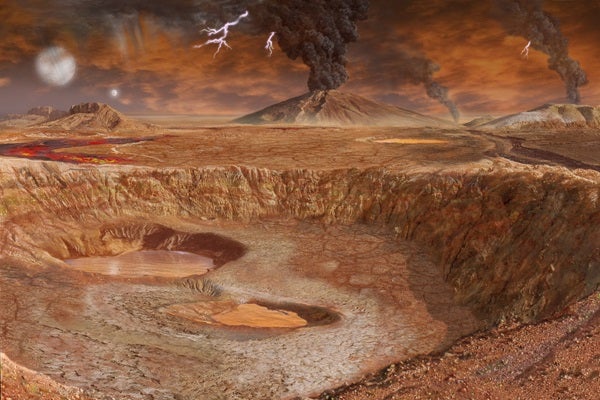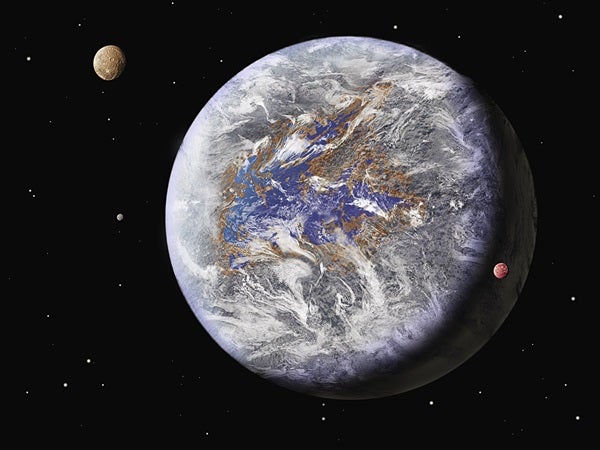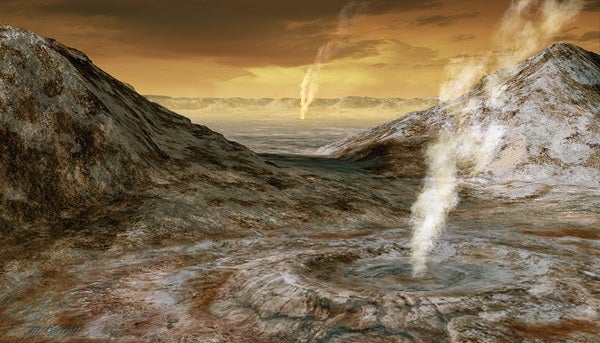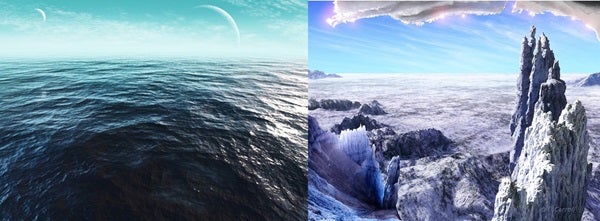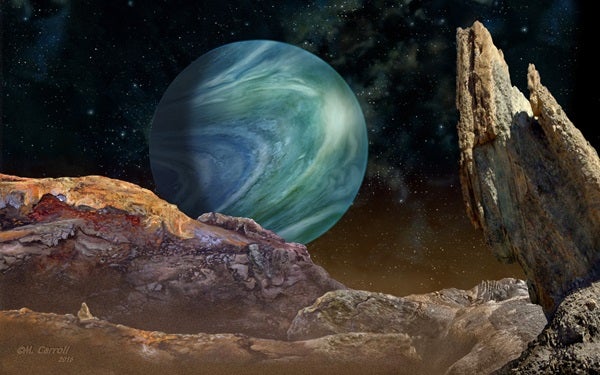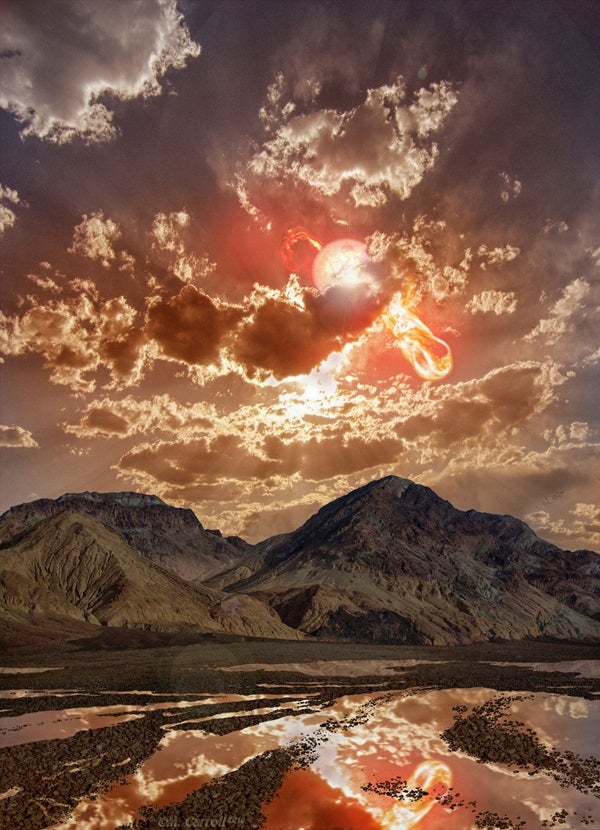Several of these recently discovered hybrid planets offer the most exciting possibilities for Earth-like conditions on other worlds. And wherever such environments exist, the chance that life might gain a foothold can’t be ruled out.
In search of Earth 2.0
Finding exoplanets isn’t easy. It’s hard to image a planet at interstellar distances because it gets lost in the glow of its host star. But astronomers are adept at teasing out planets by scrutinizing the light from distant suns. When a world passes directly in front of its star from our perspective (a transit), the star dims, and the amount of dimming depends on the planet’s physical size. The Kepler planet-hunting spacecraft used this technique to find thousands of exoworlds.
A second method, called radial velocity, measures a star’s movement as an orbiting body pulls on it. The planet’s gravity causes its sun to wobble. When the planet tugs the star away from us, the light becomes redder; on the opposite side of the orbit, the star gets yanked toward us, and its light becomes bluer. Astronomers can detect this shift in a star’s light. And the bigger the shift, the more massive the planet must be.
By combining these two techniques, scientists gain insights into the nature of exoplanets. If a planet has twice the mass of Earth but the same volume, for example, it must be very dense and thus rocky. But if a planet with Earth’s mass has 10 times our planet’s volume, it must be a low-density world like a small gas or ice giant.
Astronomers have charted a wide range of planets orbiting in their host star’s habitable zone — the region where liquid water could exist on a world’s surface — from small terrestrials akin to Mercury to rocky or gaseous worlds the size of Neptune. Our galaxy may hold 10 billion worlds with sizes comparable to our own. Among known exoplanets, however, Neptune- and sub-Neptune-sized worlds are most common. Many of these relatively small giants qualify as super-Earths.
Broadly speaking, the term super-Earth applies to planets that are larger than Earth but still have a rocky surface and a thin atmosphere. The term sub-Neptune refers to a small gaseous giant. But uncertainties in the data mean that the boundary between these two classes is more blurry than clear-cut.
Super-Earths seem to be the most common type of exoplanet. Roughly three out of every 10 worlds now known fall into this category. These worlds have no analog in our solar system. Scientists classify super-Earths strictly by mass without considering their composition, nature, or distance from their host star. Most of those discovered so far orbit close to their suns — simply because those are the easiest to detect. The masses of these worlds range from a low of about 1.5 to 2 Earth masses up to a high of 10 Earths.
Astronomers sort super-Earths into four categories. Low-density planets contain large amounts of hydrogen and helium and are referred to as dwarf or sub-Neptunes. Medium-density super-Earths probably are ocean worlds where water is a major component. A third type has a denser core than a sub-Neptune but still possesses a sub-Neptune’s extended atmosphere. The extent of that atmosphere depends on the planet’s distance from its star — the farther away it orbits, the cooler it will be, and the more atmosphere it will retain. Finally, larger, high-density super-Earths, sometimes called mega-Earths, probably include major components of rock and/or metal.
Not quite like Neptune
The ubiquitous sub-Neptunes join the exoplanet menagerie with masses ranging up to slightly less than our system’s Uranus and Neptune. (Uranus contains 14.5 Earth masses; Neptune holds 17.1.) These worlds likely come with a wide variety of personalities.
Research scientist Mark Marley models exoplanet atmospheres at NASA’s Ames Research Center in Moffett Field, California. He believes that sub-Neptunes may turn out to be the most varied of any size worlds. “You get bigger than a Saturn or so, and [planets] all tend to be about the same size because they are dominated by their hydrogen-helium atmospheres. When you get down closer to 1 Earth mass, they’re probably all rocky worlds with a little bit of atmosphere. But [in this region between Neptune and Earth], there’s probably a huge range of what these planets could be like. Every one is going to be unique,” he says. Their natures depend on many factors, including their mass, the amount of water they possess, and the size of their core.
Like Neptune, most sub-Neptunes are gaseous. Unlike Neptune, however, many of these worlds orbit near their host star. This provides astronomers with a mystery: How did sub-Neptunes end up close to their star when they had to form in the outer regions of their planetary system? Such worlds can be born only beyond the so-called snow line, where cool temperatures enable them to collect large quantities of ices and gases.
Planets, it seems, are slippery things, capable of forming in one place and shuffling off to another. Our solar system’s arrangement of gas and ice giants beyond smaller terrestrial worlds apparently is not the norm across the galaxy. Astronomers developed the Grand Tack model to explain the solar system’s early evolution. The theory proposes that Jupiter and Saturn marched toward the Sun, but Saturn was able to pull Jupiter back from the brink of death. Similar migrations may be common in other systems, where sub-Neptunes could form at a large distance and drift starward later. An Earth-like world that develops close to its sun would have a much higher density because it lacks the water content of a planet originating in a system’s cooler outer region.
How much like home?
Although the discovery of planets with terrestrial dimensions is exciting, it takes more than size to make an Earth. Even among worlds close to Earth’s size and mass, the “Earth-like” pickings appear to be slim. Most orbit outside the host star’s habitable zone.
Typical of these is the nasty Earth-sized planet circling Gliese 1132. Astronomers calculate that Gliese 1132b spans 1.2 Earth radii and has a mass about 1.6 times bigger than our planet, putting it on the border between being rocky or sub-Neptunian. As Earth-like planets go, so far, so good. But scientists estimate that its surface broils at the temperature of an oven, around 460 degrees Fahrenheit (225 degrees Celsius).
Just how Earth-like is a super-Earth? Features that contribute to our own world’s uniqueness offer a good yardstick. First, Earth orbits in the Sun’s habitable zone. Although some super-Earths orbit within the habitable zone of their own star, studies show this may not be enough to beget Earth-like environments. Plate tectonics is another critical attribute of our home world because it recirculates the minerals that wash into the seas and recycles elements of the atmosphere that have been chemically locked into rocks.
But recent models contend that super-Earths may not enjoy the benefits of plate tectonics. First, it takes the right mineral smorgasbord to create the jigsaw pattern of shifting plates. On Earth, as one plate slides under another, increasing pressure rearranges the atoms within it, making the rock denser. Without this alteration, plates would stall out and cease sliding past each other. Planets with mineralogically different crusts may not be able to maintain a conveyor belt of plates.
Second, a super-Earth’s crust may be too thick for tectonics. Simulations of giant Earths reveal that most of these worlds have thick crusts, putting up a physical barrier to plate tectonics. Still, some researchers suggest that the increased heat within a super-Earth might be enough to drive the process.
Another factor that would contribute to a super-Earth’s earthiness is a magnetic field. Earth’s rotating molten core generates a field that protects us from energetic charged particles. To be Earth-like, a super-Earth needs to have such a field.
Out of the thousands of exoplanets known, astronomers have found only a few super-Earths with the right characteristics to be potentially Earth-like. One of the closest matches appears to be Kepler-452b.
The first roughly Earth-sized planet found in the habitable zone of a star similar to the Sun, Kepler-452b is roughly 1.5 times larger than Earth. Although it lies slightly farther from its star (Kepler-452) than Earth does from the Sun, its star shines slightly brighter than ours, so the planet gets just a bit more energy than Earth does.
That is, if Kepler-452b has a solid surface. The planet’s size hovers right on the edge between a rocky super-Earth and a gaseous sub-Neptune. Columbia University astronomers Jingjing Chen and David Kipping give the planet only a 13 percent chance of being terrestrial rather than gaseous. Models suggest that if Kepler-452b is rocky, it probably has a thicker atmosphere than Earth’s and likely would be volcanically active.
Kepler-452b takes 385 days to orbit its sun, a year quite similar to Earth’s. But all may not be well on this world. Its star is 1.5 billion years older than the Sun and radiates more energy than it used to. The planet once was in the center of the habitable zone, but as the aging parent star has warmed, its habitable zone has migrated outward, stranding the planet on the inner edge. Any oceans it once had likely are evaporating into a thick atmosphere.
Other possible matches may circle Gliese 581, a red dwarf star that lies 20 light-years from Earth. Up to five planets may orbit this star, and three of them may be super-Earths in the star’s habitable zone. Gliese 581c orbits near the zone’s inner edge. It may circle close enough to the star that it suffers from a runaway greenhouse effect like that found on Venus.
The other two planets — Gliese 581d and Gliese 581g — may be more Earth-like, but astronomers aren’t even sure they exist. Both worlds have been detected by multiple teams, but other researchers have failed to confirm them. If real, they would be on the shortlist for most Earth-like planets.
If it has an atmospheric pressure similar to Earth’s, the globe might be blanketed in a thick ice crust. But if the air contains enough greenhouse gases like carbon dioxide, temperatures could be substantially warmer. The tidally locked world could develop a permanent ocean on the hemisphere facing the star, where temperatures would be similar to those in Earth’s tropics.
Gliese 581d appears to be much heavier, perhaps with as much as 7 Earth masses. This purported planet’s size caused astronomers to add a new class to exoplanets: the mega-Earth. The world apparently orbits its star with a period of 67 days, placing it near the outer edge of the habitable zone.
Kepler’s reign of glory
At a distance of 620 light-years, the Sun-like star Kepler-22 hosts Kepler-22b. The planet was the first habitable-zone world discovered by the Kepler spacecraft.
With a diameter about 2.4 times that of Earth, it has a density similar to rock, which means that it may be terrestrial. Kepler-22b also might have a fairly dense atmosphere and, because it orbits in the inner region of its star’s habitable zone, the climate may resemble Venus more closely than Earth. But the planet’s rotation and cloud cover could moderate conditions there. Some recent models point to a surface temperature hovering around a comfortable 72 F (22 C).
Studies indicate that water likely covers Kepler-62e in a deep global ocean. And although sibling Kepler-62f also may have a large component of water, it lies far enough out in the habitable zone that the surface might be frozen, at least at the poles. The latter world may have an atmosphere denser than Earth’s, perhaps similar to — but cooler than — that of Venus.
Some 22 light-years from Earth lies the triple-star system Gliese 667. Two of the members are K-type orange dwarfs somewhat cooler than the Sun, while the third is an even cooler red dwarf. The two K-type stars orbit each other; the red dwarf, Gliese 667C, circles them both at a distant 230 AU. Gliese 667C appears to have at least three planets in the vicinity of its habitable zone.
Perhaps the most intriguing of these is Gliese 667Cc, which has a mass less than four times that of Earth. This alien planet may be a rocky terrestrial, though some researchers think it may be a sub-Neptune. The world circles its sun at breakneck speed, completing a circuit in just 28 days.
But because Gliese 667C is a red dwarf, the world lies far enough out that liquid water could exist on its surface. Gliese 667Cc collects about 90 percent of the light and heat that Earth receives from the Sun. And as with any large planet in a habitable zone, it may have moons with quite Earth-like environments.
One of the most Earth-like planets yet discovered is a world with a radius 12 percent larger than our own. Kepler-438b orbits within the habitable zone of a red dwarf, making a circuit every 35 days. If Kepler-438b is terrestrial in nature, its mass would be about 1.4 times Earth’s. Surface temperatures on this world likely would range from 32 to 140 F (0 to 60 C).
The planet suffers from the disadvantage of orbiting close enough to its parent star to feel the fallout from any of the stellar flares that are so common to red dwarfs. In fact, observers have seen Kepler-438 unleashing radiation and plasma every few hundred days. But if Kepler-438b has a strong magnetic field, its surface still might be hospitable.
Astronomers have discovered a variety of exoplanets within their host star’s habitable zone. The field seems ripe for the discovery of worlds with thriving biomes beyond our own. The search for life-forms on Earths of distant suns will be a difficult one, but the detection of a new living world would forever change our views of biology, planetary development, and the frequency of life in the universe.

